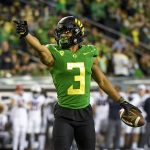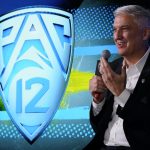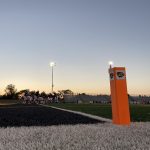The Hotline mailbag publishes weekly. Send questions to pac12hotline@bayareanewsgroup.
Please note: Some questions have been edited for clarity and brevity.
On several occasions, you have referred to the Pac-12 as a “mediocre” basketball conference. However, recall: UCLA’s title in 1995; Stanford’s impressive showings in the late 1990s; and Arizona’s title in 1997 and yearly top-10 play. What major factors would you attribute this long-standing decline to? — Jim Varnell
Goodness, this is a rich topic — and a timely one, too, with the (final) Pac-12 tournament starting next week and Selection Sunday on March 17.
The struggles in recent years, including the current season, are largely due to bad coaching.
Yep, we said it: On a collective basis, the coaching across the conference is subpar. Just look around …
Mike Hopkins is not getting it done at Washington and hasn’t for years.
Dana Altman has lost his magic touch at Oregon.
Wayne Tinkle cannot haul Oregon State out of the cellar.
Jerod Haase has yet to take Stanford to the NCAAs.
Bobby Hurley’s product at Arizona State is forever mediocre.
Craig Smith has yet to elevate Utah while Tad Boyle and Colorado meander through one season after another.
Winning is about acquiring and developing talent, which starts — and ends — with coaching.
Then add a deeply disappointing season for UCLA, one of the Pac-12’s two marquee programs, and you have a second-rate product.
In our view, the conference is long past the point of needing to overhaul the lineup of head coaches. So why haven’t large-scale changes been made?
Because buyouts are large, cash is tight and football is the enduring priority.
Many schools attempted to get football fixed — or are still trying to get football fixed — before attempting to right-set their basketball teams. It’s difficult to devote both the time and resources to the latter when your bell cow sports program is staggering.
But there’s another component to the issue of second-rate men’s basketball: The collective ceiling.
History suggests the Pac-12 simply isn’t very good outside of two schools.
If you remove UCLA and Arizona, the conference has two Final Four berths over the past 50 years. Two! Stanford reached the stage in 1998, and Oregon did so in 2017. That’s it.
(Utah was not a member of the Pac-12 when it made the Final Four in 1998.)
The Hotline would argue that above and beyond Stanford’s six or eight years as an A-lister and Oregon’s brief uptick in the late 2010s, the past 50 years of high-level Pac-12 success is really just about two schools.
How does that tally of collective Final Four appearances compare with those from other power conferences? So poorly that we won’t even bother listing the numbers.
In other words, there are two truths at play here:
The Pac-12’s performance has been below an acceptable standard in recent years; and that acceptable standard, beyond two schools, is not very high.
How likely or unlikely is it that the champion of the Pac-12 men’s tournament ends up being a bid-stealer? — @AmbitiousCoug
Because the conference has just two locks for the NCAA Tournament, Arizona and Washington State, there are 10 potential bid-stealers — teams that could claim the Pac-12’s automatic bid but would not make the NCAAs through the at-large pool.
(Granted, Utah and Colorado are bubble teams. Casting them as bid-stealers requires a somewhat loose definition of the term.)
If you’re looking for a true sleeper next week in Las Vegas, allow us to suggest USC. The Trojans struggled with injuries and other issues for months but appear to have found traction at just the right time.
In fact, don’t be surprised if they beat Arizona on Saturday in the Galen Center.
It’s extraordinarily difficult to win four games in four days in the Pac-12 tournament. But the Trojans have the talent to accomplish the feat, especially where it matters most: on the perimeter.
This might be the third or fourth season I’ve asked, but what will it take for Stanford to fire Jerod Haase? This has got to be the year it happens, right? And what about athletic director Bernard Muir? Does he have tenure? — @joshfried
We don’t believe the Cardinal has a choice: It’s high time for a coaching change. And some of the greatest players in school history agree.
I don’t know Muir’s contract situation, but he has repeatedly mismanaged the basketball program. Haase should have been dismissed two years ago.
Instead, Muir clung to the belief that Stanford would somehow morph into a contender under Haase when there was zero evidence to suggest that would be the case. And he held that view last spring, after yet another bad season, when former Stanford star Mark Madsen was available for hire.
(Good thing none of Stanford’s competitors had the foresight to hire Madsen!)
But here’s the central question: Does anyone in a position of authority care enough to force Muir to make a change? The only thing worse than Stanford’s on-court performance is the apathy that has come to engulf the program.
Arizona State fans have to be concerned with president Michael Crow’s process behind the next athletic director hire, right? — @Harris_Mark7
As we explained earlier this week, using Crow’s own words, the Sun Devils are taking their time. And yes, that approach should concern fans.
Ray Anderson announced his resignation in mid-November, and there’s no indication ASU is close to naming a replacement. In an email to the Hotline, Crow explained that he’s “making some design changes and updating our models for operations and systems before we make a decision on a new AD, so it is for us a careful and deliberate process.”
That strategy might be ideal for an alternate universe. But given the current state of ASU athletics specifically and college sports in general, the absence of a permanent athletic director leaves the Devils at significant risk of falling behind on various fronts.
They are transitioning to the Big 12; the men’s basketball team needs a serious evaluation (and possible leadership change); the department’s NIL game must be improved; football coach Kenny Dillingham needs all the support and clarity of mission that he can get. And there are other issues.
The Sun Devils were woefully behind in the NIL space — Anderson completely whiffed on that momentous issue — and they cannot afford additional setbacks.
If ASU doesn’t have someone in place by April 1, your concern should turn to panic.
What is the more likely way for Washington State and Oregon State to become automatic qualifiers (AQs) for the College Football Playoff in 2026 and beyond: Rebuild the Pac-12 with castaways from the ACC or gain membership to another power conference? — @CelestialMosh
The format for the CFP in 2026 and beyond is undetermined and the subject of intense debate. But in our view, there is no scenario that would result in WSU and OSU having access to AQs unless they somehow joined the Big 12 or ACC.
Those outcomes are unlikely, to the point of being remote.
If WSU and OSU choose to rebuild the Pac-12 with teams from the Mountain West, which is our expectation, the conference would be treated like the Group of Five.
There would be a single AQ spot available for the best team that’s not in one of the power leagues. The SEC and Big Ten won’t allow for anything beyond the bare minimum needed to avoid a lawsuit.
That said, WSU and OSU would also have CFP access (albeit extremely limited) through the at-large pool.
Are you optimistic about the future of the Pac-12 Network? — @TerryTerry79
We haven’t been optimistic about the networks since the early days of their existence, before the DirecTV ship sailed off to faraway lands occupied only by Larry Scott’s hopes and dreams.
There has been no change in our view.
The networks will cease to exist as a media distribution company on June 30, when the carriage contracts expire. However, Pac-12’s production studio will remain operational for at least a year to assist Washington State and Oregon State with their broadcast requirements.
What might those be?
Well, the West Coast Conference’s media deal includes a significant number of Olympic sports broadcasts on ESPN+. Because WSU and OSU will be affiliate members for two years, they, too, must make home games available for digital distribution.
The Pac-12 production team in San Ramon — or a scaled-down version of it — will help the schools with production.
Beyond that, there’s a chance the infrastructure could be sold or leased to a major media company. We’ll believe it when we see it and presume that at some point, the studio will be shut down for good.
Please list former commissioner George Kliavkoff’s five biggest errors during his Pac-12 tenure, in your opinion. — @Jalex0077
You could dissect the specifics of Kliavkoff’s media strategy — everything from his choice of consultants and his approach with UCLA and the UC regents to the refusal to expand before the collapse — but it’s probably more productive to focus on three broader issues:
Relationships: Kliavkoff never understood the fundamental tenet that college sports is a relationship business. He failed to forge the connections between essential stakeholders and opted to run the conference via Zoom. As a result, he was unable to properly manage the board.
For instance, the moment Oregon and Washington expressed skepticism over the proposed Apple deal, on Aug. 1, Kliavkoff should have been on planes to Eugene and Seattle to meet with the presidents and athletic directors. Instead, he attempted to ease concerns remotely.
Disconnect: In part because he failed to create personal relationships, Kliavkoff was totally unaware that USC and UCLA were leaving for the Big Ten on June 30, 2022. He was vacationing in Montana at the time.
But that’s hardly the only example of the disconnect.
Kliavkoff never realized that the schools, burned by a decade of unmet revenue and distribution promises with the Pac-12 Networks, were in no mood for an all-streaming deal in which revenue was hooked to meeting subscription tiers. Yet Kliavkoff thought they would welcome his proposal.
Urgency: No aspect of Kliavkoff’s strategy was more suspect than his ignorance of the need to hustle — to get a media deal secured sooner than later. Once the conference emerged from the holidays in early 2023 with no sign of a resolution, we sounded the alarm.
Realignment is not a stroll in the park; it’s a race for survival. The presidents and athletic directors were under intense pressure, especially once the process reached the spring of 2023, to secure a deal.
The longer Kliavkoff waited, the greater the risk that his strategy would fall apart.
We could go on … and on. But those are three of the critical failures.
What will be Kliavkoff’s next job? — @WorkishFromHome
Our best guess: He will lay low for a year while living off his multi-million settlement with the Pac-12, then become an executive with one of the Las Vegas resorts/casinos.
Someone will lean into his well-regarded tenure running MGM’s sports and entertainment division and give him a pass for the epic fail with the Pac-12.
Needless to say, he will never work in college sports again. In that world, history will regard his tenure as a complete and utter failure.
*** Send suggestions, comments and tips (confidentiality guaranteed) to pac12hotline@bayareanewsgroup.
*** Follow me on Twitter: @WilnerHotline
*** Pac-12 Hotline is not endorsed or sponsored by the Pac-12 Conference, and the views expressed herein do not necessarily reflect the views of the Conference.
Related posts:

Oregon wide receiver Johnny Johnson III (3) Eugene, Ore. (AP Photo/Andy Nelson)
Wilner Hotline – Oregon Ducks Hire First-Time Head Coach
(AP Photo/Marcio Jose Sanchez)
Commissioner George Kliavkoff on the state of Pac-12 football (‘We’re in the valley’) Wilner Mailbag: Next steps for the ‘Pac-2’ schools and a possible reverse merger with the Mountain West
Wilner Mailbag: Next steps for the ‘Pac-2’ schools and a possible reverse merger with the Mountain West
 Huffman on Pac-12 recruiting: Cal and UCLA roll on, Oregon State comes alive and Stanford goes national
Huffman on Pac-12 recruiting: Cal and UCLA roll on, Oregon State comes alive and Stanford goes national


